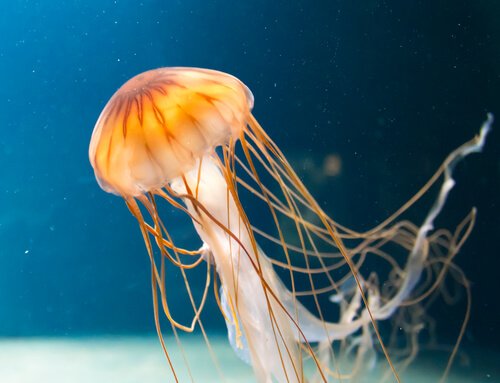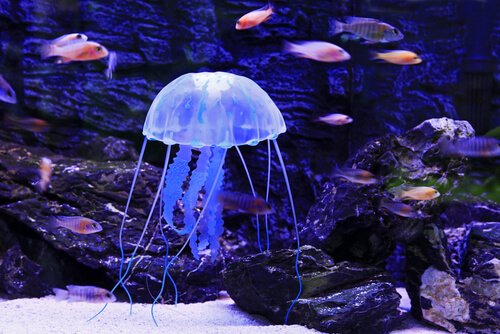How to Avoid Getting Stung by a Jellyfish

Jellyfish are famous for their gelatinous bodies. This animal’s upper body is shaped like a hat, and its lower body is made up of tentacles. Since jellyfish stings are so painful, naturally most people panic and become very frightened as soon as they see one. However, to avoid getting stung by one, it’s important to remain calm and act accordingly. Continue reading to learn what to do when you come across a jellyfish.
Main Traits of Jellyfish
Fist, start by getting a deeper understanding of this fascinating marine animal. Jellyfish are easy to recognize thanks to their “bell-shaped” body and long tentacles, which form a veil around it.
They also draw people’s attention because of their gelatinous appearance. Since jellyfish move really fast, their upper bodies are filled with water while they swim. Some species of jellyfish even have the ability to glow to defend themselves against predators.

This animal’s tentacles are made up of stinging cells, which they use to capture their prey or to avoid being captured by predators. Each of their filaments injects venom, and the toxicity varies depending on the type of species that got stung.
As far as humans are concerned, getting stung by a jellyfish causes burning sensations, redness, swelling and pain. On the other hand, the “sea wasp jellyfish,” including other larger specimens, (Cyanea and Physalia) can kill a person within minutes. Fortunately, most other species inject a liquid that is not dangerous to humans.
How to Avoid Getting Stung by a Jellyfish
You can do this by keeping away from the areas where they normally appear. You should always do your best not to disturb or touch them. This is true even when they are dead on the seashore because their venom remains dormant several days after death.

Here are some of the best tips on how to avoid getting stung by a jellyfish:
1. Be Aware of Your Surroundings
The coastguards and local residents usually know where jellyfish usually swim at and the number of them in the area. Especially if they are places where a lot of people have gotten stung before.
To avoid getting stung by a jellyfish, it’s important to avoid swimming when it’s really windy. This is because the wind actually “carries” the jellyfish much closer to the shore than normal. If a certain area usually has groups of jellyfish, also known as “smacks” or “swarms”, you should get out of that location as soon as possible.
2. Pay Attention to Warning Signs
When it comes to places that are known for attracting jellyfish, there are usually signs that warn tourists and travelers. Some of these signs are permanent, and others are placed by the coastguard when there are spottings of large jellyfish populations.
Purple flags are placed on some coasts to indicate that it’s either jellyfish season or the season for other types of dangerous marine animals. So, don’t get in the water if you see any purple flag waving along the shoreline.
3. Protect Yourself
Always wear shoes if you are going to take a walk on the beach or by the shoreline. This preventative measure will help you avoid accidental contact with dead or dying jellyfish, or even with ones that are still alive.
When walking barefoot you have more chances of hurting yourself with a stone, shell or any object on the beach. And you will be more vulnerable to jellyfish or crab bites!
If you walk barefoot, you dramatically increase the chances of stepping on something and hurt yourself. Whether that something is a shell, glass, a rock, or any other kind of random object, your well-being is not worth putting your safety on the line.
While swimming or surfing, your best option is to wear a neoprene wetsuit that covers most of your body. This way, if a jellyfish tries to sting you, you are protected by an extra layer of thick fabric.
4. Do Not Touch Them
Shored jellyfish often look like plastic bags lying in the sand. So, be very careful if you see something on the ground that resembles a bag, and be absolutely sure it’s trash before you pick it up.
If it’s a jellyfish, the first thing you should do is tell the coastguards. They will take care of either disposing of the dead jellyfish, or returning it to the sea if it’s still alive.
5. Scare Them Off
A great technique to avoid getting stung is dragging your feet through the sand while you walk through the water. Contrary to popular belief, the animal will not sting you and instead will flee.
If you tend to panic at the sight of jellyfish and think there might be one nearby, you should immediately get out of the water. However, you have to do it calmly or you risk scaring the jellyfish and cause it to sting you. Once you’re back on the shore, be sure to warn the coastguards about what you saw so they can act accordingly.
Jellyfish are famous for their gelatinous bodies. This animal’s upper body is shaped like a hat, and its lower body is made up of tentacles. Since jellyfish stings are so painful, naturally most people panic and become very frightened as soon as they see one. However, to avoid getting stung by one, it’s important to remain calm and act accordingly. Continue reading to learn what to do when you come across a jellyfish.
Main Traits of Jellyfish
Fist, start by getting a deeper understanding of this fascinating marine animal. Jellyfish are easy to recognize thanks to their “bell-shaped” body and long tentacles, which form a veil around it.
They also draw people’s attention because of their gelatinous appearance. Since jellyfish move really fast, their upper bodies are filled with water while they swim. Some species of jellyfish even have the ability to glow to defend themselves against predators.

This animal’s tentacles are made up of stinging cells, which they use to capture their prey or to avoid being captured by predators. Each of their filaments injects venom, and the toxicity varies depending on the type of species that got stung.
As far as humans are concerned, getting stung by a jellyfish causes burning sensations, redness, swelling and pain. On the other hand, the “sea wasp jellyfish,” including other larger specimens, (Cyanea and Physalia) can kill a person within minutes. Fortunately, most other species inject a liquid that is not dangerous to humans.
How to Avoid Getting Stung by a Jellyfish
You can do this by keeping away from the areas where they normally appear. You should always do your best not to disturb or touch them. This is true even when they are dead on the seashore because their venom remains dormant several days after death.

Here are some of the best tips on how to avoid getting stung by a jellyfish:
1. Be Aware of Your Surroundings
The coastguards and local residents usually know where jellyfish usually swim at and the number of them in the area. Especially if they are places where a lot of people have gotten stung before.
To avoid getting stung by a jellyfish, it’s important to avoid swimming when it’s really windy. This is because the wind actually “carries” the jellyfish much closer to the shore than normal. If a certain area usually has groups of jellyfish, also known as “smacks” or “swarms”, you should get out of that location as soon as possible.
2. Pay Attention to Warning Signs
When it comes to places that are known for attracting jellyfish, there are usually signs that warn tourists and travelers. Some of these signs are permanent, and others are placed by the coastguard when there are spottings of large jellyfish populations.
Purple flags are placed on some coasts to indicate that it’s either jellyfish season or the season for other types of dangerous marine animals. So, don’t get in the water if you see any purple flag waving along the shoreline.
3. Protect Yourself
Always wear shoes if you are going to take a walk on the beach or by the shoreline. This preventative measure will help you avoid accidental contact with dead or dying jellyfish, or even with ones that are still alive.
When walking barefoot you have more chances of hurting yourself with a stone, shell or any object on the beach. And you will be more vulnerable to jellyfish or crab bites!
If you walk barefoot, you dramatically increase the chances of stepping on something and hurt yourself. Whether that something is a shell, glass, a rock, or any other kind of random object, your well-being is not worth putting your safety on the line.
While swimming or surfing, your best option is to wear a neoprene wetsuit that covers most of your body. This way, if a jellyfish tries to sting you, you are protected by an extra layer of thick fabric.
4. Do Not Touch Them
Shored jellyfish often look like plastic bags lying in the sand. So, be very careful if you see something on the ground that resembles a bag, and be absolutely sure it’s trash before you pick it up.
If it’s a jellyfish, the first thing you should do is tell the coastguards. They will take care of either disposing of the dead jellyfish, or returning it to the sea if it’s still alive.
5. Scare Them Off
A great technique to avoid getting stung is dragging your feet through the sand while you walk through the water. Contrary to popular belief, the animal will not sting you and instead will flee.
If you tend to panic at the sight of jellyfish and think there might be one nearby, you should immediately get out of the water. However, you have to do it calmly or you risk scaring the jellyfish and cause it to sting you. Once you’re back on the shore, be sure to warn the coastguards about what you saw so they can act accordingly.
This text is provided for informational purposes only and does not replace consultation with a professional. If in doubt, consult your specialist.







